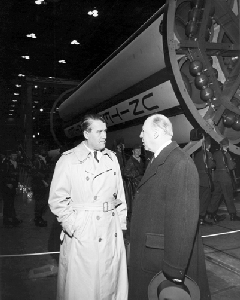Redstone Arsenal

Location of Restone Arsenal.

Wernher von Braun (left) and US Army Secretary Wilbur Brucker in the Army Ballistic Missile Agency Fabrication Laboratory in 1960.
Redstone Arsenal has, for more than six decades, been the United States Army's center for missile and rocket programs; it is located at the southwest side of the city of Huntsville in central north Alabama. In October 1997, the US Army Missile Command at Redstone Arsenal combined with the US Army Aviation and Missile Command at St. Louis, Missouri, to form the US Army Aviation and Missile Command (AMCOM). Today, Redstone Arsenal continues to research, develop, test, purchase, repair, or maintain high technology weapons. NASA's Marshall Space Flight Center is also housed at Redstone.
The Army' s missile and rocket program began in 1950 under Wernher von Braun and his team of German scientists. The 500-mile surface-to-surface Redstone developed here became the first large US ballistic missile systems to become operational.
Redstone Arsenal sits on 40,000 acres, and includes administrative buildings, laboratories, flight test ranges, and other specialized buildings and equipment. The center was built in World War II as three separate installations for the Chemical Warfare Service: the Huntsville Arsenal, the Redstone Ordnance Plant, and the Gulf Chemical Warfare Depot. Initially known as Redstone Ordnance Plant, the plant was redesignated Redstone Arsenal in February 1943. Since the inception of Redstone Arsenal, it has been a matter of recorded history that the name Redstone came from "the preponderance of red soil."
Because of the large available space, empty buildings, and ease of access to rail, highway, and water traffic, the Army chose Redstone as the place to consolidate its newly formed rocket program. On 1 February 1956 the Army Ballistic Missile Agency was established. The core of the new agency came from the Guided Missile Development Division of Redstone Arsenal's Ordnance Missile Laboratories. From this division, ABMA inherited some 1,600 personnel, including the team of German scientists headed by von Braun and 1,100,00 square feet of space in buildings. During the 1950s, the Army missile team at Redstone pioneered many of America's first achievements in space exploration. On 21 October 1959, President Eisenhower ordered components of the military's space program to be transferred to NASA. Thus in July 1960, a substantial proportion of ABMA facilities was leased to NASA to become the George C. Marshall Space Flight Center. Some of these facilities later received national historic recognition for their presence during both the ABMA and NASA eras. Constructed in 1953, the Redstone Rocket Test Stand (Building 4665) is listed as a Category I property on the National Register of Historic Places. The test stand had been the first that was capable of accommodating the entire launch vehicle during static tests. Category II properties dating from the pre-NASA era include the Neutral Buoyancy Simulator (Building 47051, the Solid Rocket Motor Propulsion and Structural Test Facility (Building 4572), and the Structures and Mechanics Laboratory (Building 4619). Effective 1 July 1960, Redstone Arsenal lost all of its space-related missions, along with some 4,000 civilian employees and $100,000,000 worth of buildings and equipment at Redstone Arsenal and Cape Canaveral, Florida, to NASA's George C. Marshall Space Flight Center, which was officially opened that day at Redstone Arsenal.
Army Ballistic Missile Agency
The Army Ballistic Missile Agency (ABMA) is an organization formed by the United States Army on 1 February 1956, at Redstone Arsenal, Huntsville, Alabama, taking over what was previously the Guided Missile Development Division, to develop the Redstone and Jupiter ballistic missiles. Its first commander was Major General John Mendaris. In July 1960 ABMA's buildings and staff, including Wernher von Braun, were transferred to NASA's Marshall Space Flight Center, which remains in the midst of the Redstone Arsenal.


